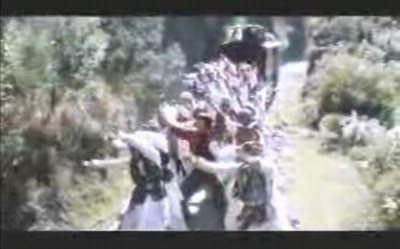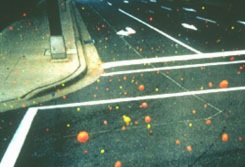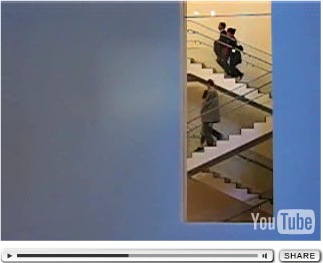
Iain Anderson’s Airport is an animated short film made entirely of AIGA-standard travel icons. Very cute.
Airport by Iain Anderson [funwithstuff.com via boingboing]
There Are Many Paths To The Top Of Mt. Fuji
That fall the curious flocked to Gladstone’s gallery to watch a film depicting him scaling the gallery walls with the help of ice screws. It ended with Barney inserting the last screw into his anus. Stardom came instantaneously.
Unfortunately, the rest of “Barney’s Voyage,” Julie Belcove’s profile of Matthew Barney and Drawing Restraint 9 for W Magazine, is not available online.
But Randy Kennedy’s profile for the Times is, and he clears up the whole “Bjork and Matthew Barney live in New Jersey!” mystery that had the Noel Coward people so up in arms.
Sikhs On A Train

As soon as it started, I knew that “Chaiyya Chaiyya,” a song from the 1998 breakout Indian film Dil Se directed by Mani Ratnam with music by A. R. Rahman, would make my list of Favorite Music Videos Shot On A Train.
Right now it’s duking it out with Lars von Trier’s and Bjork’s train song from Dancer In The Dark from the top spot. It is, at the moment, a two-song list.
Chaiyya Chaiyya, from Dil Se [youtube via tmn]
Previously: 101 Cameras: Lars von Trier and Me
Death And Venice

Felix Gonzalez-Torres: “All art and all cultural production is political.”
The NY Times report on the inclusion of Felix Gonzalez-Torres’ works in US Pavilion next year in Venice gives more information on what was included in the Guggenheim’s proposal. Here is what the pieces soud like to me, starting with the “never before realized” work, which will be installed in the entrance courtyard of the pavilion:
Like that “figure eight = infinity” bit, Carol Vogel provided cleanly didactic interpretations of Felix’s symbolism: “stacks of replenishable paper to represent the inevitability of death, strings of lights to represent dreams of a better world.” So it’s odd that a presumably easy-to-read “symbol” like a black border–which, on stationery and signage, has long signified a house in mourning–didn’t get a mention. Nor did the title: Untitled (Republican Years).
1985 Act Up 1989 FU State Dept. 1996 Died 2007 Venice Biennale

Like death and taxes, the State Department will catch up with you. One day.
From an interview Felix Gonzalez-Torres once did with Rob Storr
For example, here is something the State Department sent to me in 1989, asking me to submit work to the Art and Embassy Program. It has this wonderful quote from George Bernard Shaw, which says, “Besides torture, art is the most persuasive weapon.” And I said I didn’t know that the State Department had given up on torture – they’re probably not giving up on torture – but they’re using both. Anyway, look at this letter, because in case you missed the point they reproduce a Franz Kline which explains very well what they want in this program. It’s a very interesting letter, because it’s so transparent.
Another example: when you have a show with white male straight painters, you don’t call it that, that would be absurd, right? That’s just not “natural”. But if you have four Black lesbian sculptors from Brooklyn, that’s exactly what you call it, “Four African-American Lesbians from Brooklyn.”
Now, ten years and a couple of months after his death, the State Department announced that Gonzalez-Torres’ work has been selected for the US Pavilion at next year’s Venice Biennale. Nancy Spector, who wrote the book on Felix–no, the other one; the one that Andrea Rosen didn’t write–will curate.
According to the State Department press release, “For the exhibition, Ms. Spector will include a new work, made from a drawing by Mr. Gonzalez-Torres but unrealized in his lifetime.”
As Felix’s Cuban–I mean, Cuban-American–countryman was famous for saying, somebody’s got some ‘splainin’ to do.
Cuban-American Artist To Be Featured at International Exhibit [state.gov via artforum]
previously: On Politics and Art
Walker Center Nice
I want to love the Walker Center’s Walker Channel video streams even more than I do.
There was a chat between Rirkrit Tiravanija and writer Bruce Sterling, for example [here’s the Walker’s blog post about it]
And Philippe Vergne talking with Dan Graham and his collaborators on his punk puppet opera Don’t trust anyone over 30.
And of course, Tyler was on the edge of his seat, waiting to watch the knives fly in realtime during the Whitney Biennial recap with Philippe and Chrissie Iles.
But unfortunately, the videos just aren’t doing it for me. They’re polite and non-confrontational to the extreme; they capture all of the tedium of a public event–including too-long intros and fawning, populist comments [Philippe actually asked Dan Graham, in his French accent, “Wat de heck am I looking at ‘ere?”]–with none of the excitement of being in the room.
And while the Rirkrit/Bruce dialogue mashup probably seemed great on paper, it didn’t work out. It was obvious that, by personality or arrangement, Bruce was “supposed” to be the “host,” asking questions, but he couldn’t help but launch into his own set pieces about how many laptops he has and how he powers them. Rirkrit, bless his heart, managed to come off as deeply incurious, even though he was presumably there to be asked about his work.
Finally, I don’t know if it’s my NYC-impaired hearing or some self-effacing Minnesota Nice thing about forcing people to listen harder by talking really quietly, but it’s nigh-impossible to hear what these kids are saying. Turn up the volume, people!
So I’ll just wait politely here until these bumps get ironed out. Which might happen sooner if even one other museum in the country had as ambitious an online program…
Walker Channel [channel.walkerart.org]
Follow The 250,000 Bouncing Balls
 Joel, an eagle-eyed greg.org reader sends in this tip:
Joel, an eagle-eyed greg.org reader sends in this tip:
Maybe nobody in the history of advertising had thought to do this, but it would appear that an artist had. Lucy Pullen, a Canadian artist living in Victoria, BC, dumped thousands of superballs onto the streets of Halifax in 1997.
Pullen has shown in London and extensively in Canada, too; not that there’s any monopoly on the idea of a mass ball bounce–we once rolled a dozen thrift shop bowling balls down a very long staircase in college in the middle of the night, a wildly ignorant, dangerous thing to do–but still, it’s interesting to see where and how an idea is manifest.
“2500 Superballs,” 1997, Lucy Pullen in collaboration with Sandy Plotnikoff [iamvariable.com]
Previously: the making of Sony Bravia’s bouncing superball ad
60-Second Films: The MoMA Stairway

David’s a photographer–and the creator of the untouchably cool pre-pixellated logo clothing for reality TV contestants that burned through the blogs last week–who’s started a little series of 60-second [give or take] movies.
This one is of my favorite vista at Taniguchi’s MoMA, across the atrium to the floating staircase with the Matisse at the top and the Diebenkorn at the bottom. Very busy, that staircase.
60 Seconds in the Life of a Staircase [ironicsans.com]
Hiroshi Sugimoto Events We Will Unfortunately Miss, Vol. 4
Hiroshi Sugimoto created a stage for a Noh performance at Dia; unfortunately, it was in October 2001, not a real hot time for cultural diversions in downtown New York City. Missed it.
The Noh stage was reinstalled at the Mori Museum at Roppongi Hills, which we also missed.
Now, tonight at the Hirshhorn, two musicians are premiering a piece created for the artist’s exhibition. Then after that, Sugimoto himself will perform as benshi, or stageside storyteller/narrator, for Kenzo Mizoguchi’s 1933 silent masterpiece, The Water Magician. Japanese silents are rarely, shown anywhere these days.
6 and 7 pm: Specification Fifteen, a live world premiere of a new musical work created especially for the Hiroshi Sugimoto exhibition, Lerner Room. For more information about Richard Chartier and Taylor Deupree, visit their websites at http://www.3particles.com and http://www.12k.com.
6:30 pm: Curator’s tour with Kerry Brougher, second level
8 pm: The Water Magician, 1933, Ring Auditorium. Film courtesy of the collection of the National Museum of Modern Art, Tokyo.
Please be advised that seating in the Ring Auditorium is limited, and we anticipate a high turn-out for this event. Ticket distribution for the film, The Water Magician, begins at 7:15 pm. Please form a line just outside the Emergency Exit doors to the right of the Information Desk. Guests may enter the auditorium beginning at 7:45pm. Entry to the auditorium will not be permitted after 8pm. Please plan your visit accordingly.
I’m sure the lines are already out the door. It’d be great if the Hirshhorn had some ticketed events open only to big-time donors. Giving money for exclusive access to taxpayer-funded institutions is a Washington tradition…
Hirshhorn After Hours [hirshhorn.si.edu, non-permanent link]
Hiroshi Sugimoto programmed a Japanese cinema series at The Japan Society last fall [via twi-ny.com]
Midnight Eye has an awesome overview of Japanese silent film and an interview with a leading benshi, Midori Sawato [midnighteye.com]
With All Due Respect…
Maybe it’s just me, but whenever I hear a guy talking about himself in a documentary and he utters the phrase, “Never in the history of advertising,” my BS detector goes haywire. Even if the rest of the sentence is, “has anyone thought to throw 250,000 balls down a San Francisco street.”
The Making Of minifeature for that Sony Bravia ad is interesting, but not as cool as the extended edit of the commercial itself, which isn’t as good as the 1min version. [crappy res on google video, lo- and hi-res on bravia-advert.com]
The making of was documented in realtime on flickr, seems like ages ago. [sepiatone at flickr]
From The Funniest Sentence Of The Day Dept.

“It’s a nice masculine aesthetic,” said Robert Tagliapietra, who with his similarly bearded partner, Jeffrey Costello, designs a collection of pretty silk jersey dresses under the Costello Tagliapietra label.
Also, Ulysses S. Grant does not actually appear in Cold Mountain. So which one did the guy from Vice Magazine not want to admit was his real inspiration: the $50 bill or the bearded Jude Law?
Paul Bunyan, Modern-Day Sex Symbol
Hey, It Does Rhyme With “Chick”!
You’re making a short story about a couple of gay, white trash shepherds into a movie. The story’s been optioned but undevelopable since it came out [sic]. In 2003-4, it looks like you might pull it together as “a low-budget, art house film, with no prospect of making any money,” but only if you can pull in some actual star power, which, considering the subject matter, is no small feat.
After all, only the bravest, most talented actors are willing to risk being typecast. Only artists of the utmost integrity would put their booming careers and hard-won status as a ladies’ man in jeopardy. What if, the reasoning goes, just because you play one in a couple of scenes, people assume you’re a selfish, mean-spirited, homophobic prick and never want to work with you again?
Deeply committed to their craft such an actor makes sacrifices, working tirelessly for weeks on end–OK, maybe a week of shooting, plus some foley time–for “economically unfavorable art film terms.” That means–unless his agent just stepped off the farm, too–that he takes deferrals and points on the backend instead of his typical eight-figure fees.
The movie gets made. It’s a critical darling and a surprise financial success. Everyone involved in the project basks in the glow of an important job well done, and they are gracious in public and private as their careers move to even greater heights.
At least that’s the way it goes with gay shepherd movies. For gay cowboy movies, some washed up bit player makes a lame-ass joke at the Golden Globes that falls completely flat, then he up and sues the producers of “movie laundering” by obtaining his oh-so-valuable services on the cheap by pretending to make a non-commercial film. The damages sought: $10 million-plus.
The moral of this story: nobody–but nobody–messes with Randy Quaid.
Randy Quaid Sues Over ‘Brokeback’ [tmz.com]
Douglas Coupland Interviewed Morrissey
I like interviews with creatives as a way to learn more about their process and to understand better how a work came to be. Interviewing someone can be a chance to learn from someone I admire how he sees the world and how he goes about bringing his ideas to fruition.
When I interviewed Sofia Coppola and she told me she’d never seen Caddyshack, I was stunned, but I didn’t make a big deal about it at the time; she was nice and I didn’t want to embarass her. [I hope you’ve seen it by now, Sofia. I’ll ask you about it again.]
Of course, from the interviewee’s standpoint, they have to do a million of these things, and they often just want the work to stand on its own. Then, too, there’s the invasive cult sycophancy aspect of divulging every nook and cranny of your soul.
Anyway, it all comes to mind as I read the slightly-too-meta account by Douglas Coupland–who hates interviews and interviewing–of traveling to Rome to interview Morrissey–who hates interviews and being interviewed.
Papal attraction [guardian/observer via tmn]
Chinese Gold Farmers Docu On YouTube

“I suddenly realized that exporting virtual items through the Internet is the same as transmitting Chinese labor to America.” That’s how the owner of a “gold farming” company in China explains his business in Chinese Farmers In Gamedom, a documentary-in-progress by
UCSD PhD candidate Ge Jin. The companies employ people to play video games all day in order to accumulate in-game gold or to build in-game equipment, which is then sold to American gamers for real money.
One entrepreneur talks about having to close his company down when complications with his borrowed Paypal account left him unable to sell his products on ebay.
Ge hears the gamers talk about work satisfaction and real vs. virtual worlds, but a stronger theme seems to be percieved hierarchy and exploitation. It turns out Chinese gamers find it insulting when thier American customers call them “farmers.” One company owner explains how his is, in fact, a service business. Ge splits the difference by calling the companies “computer workshops” in his captions.
Ge has posted a 6 min preview of Chinese Farmers In The Gamedom on YouTube. [youtube via wmmna]
Terra Nova has some excellent comments, including some from the filmmaker himself. [terranova]
0 Yen Houses, 0 Yen Movies

In 2004, Kyohei Sakaguchi published 0 Yen Houses, a book of photographs of street people architecture in Tokyo, Osaka, and Nagoya. A burgeoning urban street population, mostly men in their 50’s and 60’s, is one consequence of the Japanese economic and real estate situation over the last 10-15 years. These men often continue to work, but they’re unable to afford housing, so they improvise their own, squatting on public lands (river banks and parks, mostly). They often form the favelas that preoccupy the nomadic scavenger-artist Tadashi Kawamata [who, after 20+ years of roaming, might be able to come home now that Japan has some, too.]
Police give advance notice when they’re coming to inspect, so the street people are able to move their houses–and then replace them after the police have gone.
This kind of accommodation to the extreme prices and densities of Japan is like a grey market version of Atelier Bow Wow’s study of Pet Architecture, the impossibly tiny structures that inhabit even the most improbably small slivers of land in Tokyo. [On the other end of the spectrum, of course, is Klein Dytham’s Billboard Building, a 2m-wide (at most) spec bldg put up on a former 3-car parking lot in the extremely expensive Hiro-o neighborhood after the road was widened–and the parking lot was rendered unusable.

It turns out that Sakaguchi first gained attention for some video pieces he did while still in college [Waseda U.’s architecture program]. Whether they’re art, documentary, or home movies, who can say, but they seem to fit the jishu eiga/self-made movie mode pretty well. The first, Living in a Water Tank, is just what it sounds like, a video diary of the 21-year-old Sakaguchi’s life inside an unused apartment building rooftop water tank.

Then he made House Biker, in which he cruised around Tokyo on a pimped out pizza delivery scooter with a functioning microhouse on the back. He called it his “O Yen Movie,” a retroactive extension of the new “Zero Yen” brand.
Sakaguchi’s work seems to provoke some embarassment and discomfort among Japanese audiences, but like most things in Japan, it mostly just entertains. Take last year’s Zero Yen House Tour, in which Sakaguchi led a bunch of college students in a contest to build their own shelters using only scavenged materials. If only their plight wasn’t so aesthetically interesting, who knows, they might get some help; but right now, these homeless guys might be too cool for their own good.
0 Yen House, published by Little More and available at amazon-uk [littlemore.co.jp]
0 Yen House Tour, Kyoto Seika Univ. [kyoto-seika.ac.jp]
Happiness is just a riverside shack for designer homeless [timesonline, “designer homeless”?? via archinect]
Sakaguchi Kyohei’s homepage, mostly in Japanese, but there’s a link to autotranslations as well. [kyohei sakaguchi]
